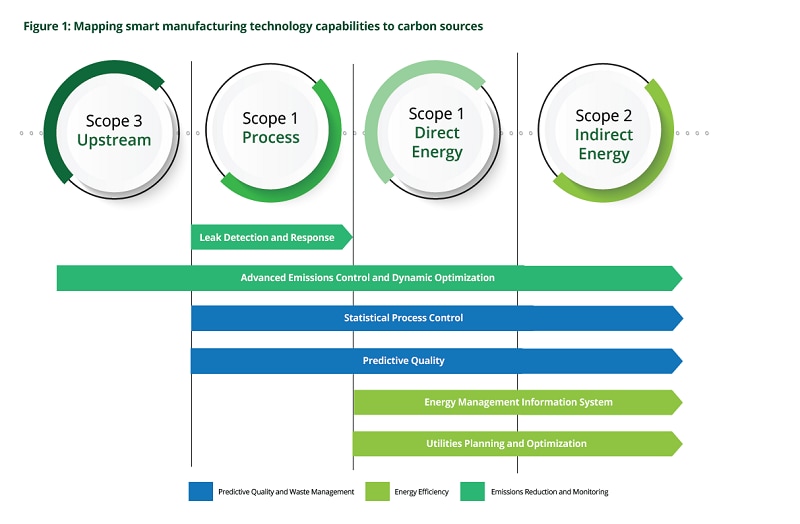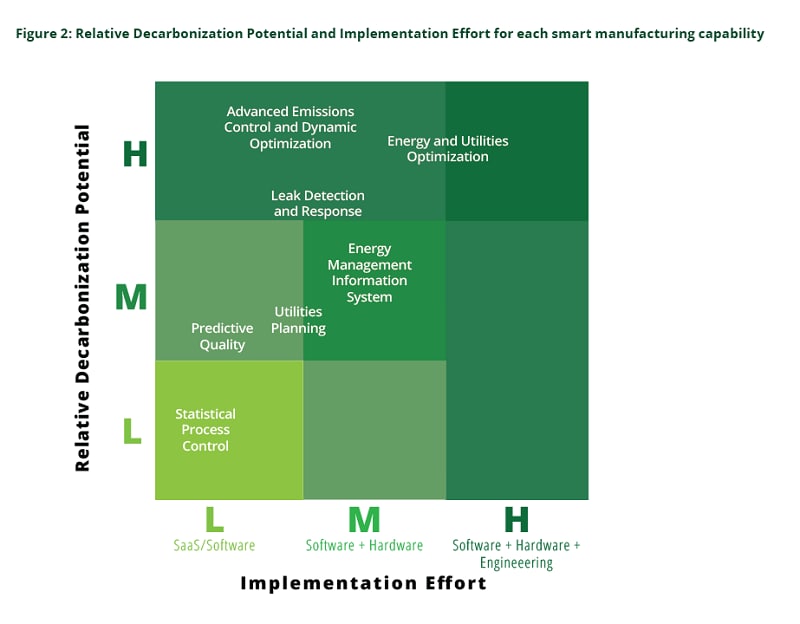Accelerate sustainability in process manufacturing has been saved

Perspectives
Accelerate sustainability in process manufacturing
Get to net-zero faster with smart manufacturing
Despite a reputation as “hard to abate,” process manufacturing companies are actively crafting sustainability strategies to reach their net-zero decarbonization goals. Discover how smart manufacturing technology is helping them accelerate the path toward sustainability through better emissions reduction, energy efficiency, and waste minimization.
How process manufacturing industries can accelerate sustainability transformation
For companies in the energy, downstream refining, chemicals, and materials industries, decarbonization and emissions reduction are critical for the path to net-zero. Due to their position in the value chain, reductions in their scope 1 (direct energy and process emissions) and scope 2 (indirect purchased energy and steam) emissions have impacts on the scope 3 emissions of various other industries, such as consumer goods, transportation, and construction, to name a few.1 Many important reduction levers involve technologies and supply chains that are still evolving (e.g., carbon capture and storage, clean hydrogen).2 There are, however, critical steps companies can take now to reduce their scope 1 and 2 emissions from existing assets and brownfield operations that will set them up for greater success when they can implement the larger transition levers that will achieve critical reductions.
3 key areas where smart manufacturing accelerates decarbonization and sustainability
In the full report, we explore three key areas in which smart manufacturing capabilities accelerate the decarbonization and sustainability transformation of energy and chemical companies. These capabilities and technology solutions address many sources of carbon—emissions, energy, and waste (figure 1).
 |
Please click on the below sections to expand and explore the details of how smart manufacturing can accelerate decarbonization and sustainability in these key areas.
How to get started on smart manufacturing-enabled decarbonization and sustainability
Similar to the safety and health transformation journeys of the previous decades, the transition to sustainable manufacturing is both an imperative and a challenge. Industries today face several complexities, from technological shifts to evolving regulatory landscapes. Traditional processes, reliant on fossil fuels for high temperatures, pose significant hurdles in the shift to sustainable alternatives.
Yet, amid these challenges lies the opportunity to redefine manufacturing for a greener future. Recognizing these intricacies is the first step in crafting effective solutions.
The future of sustainable manufacturing starts with the seamless utilization and integration of advanced technologies to achieve both sustainability and efficiency. Global decarbonization challenges need to be addressed from the perspectives of people, process, and technology. The role of organizational culture and change management in embracing these sustainability priorities and enabling new technologies cannot be understated. To achieve the ambitious decarbonization targets set for the coming years, sustainability should be truly embedded into operations and business culture, driving behaviors from key performance indicators to incentives.
It is imperative that the industry transform to a “sustainability culture,” in which employees are empowered to advocate and ensure sustainable operations as a priority, enabling the success of the decarbonization journey toward net-zero.
Companies also need to consider their unique operational challenges in achieving their sustainability goals. Beyond developing an overall corporate sustainability and decarbonization strategy, they should develop a multiyear plan and road map to achieve those targets along with the operating model and organizational change management to enable the transformation. Defining and prioritizing the initiatives for transforming existing brownfield plants and operations utilizing smart manufacturing technologies such as AI/ML, IIoT, and advanced analytics should be a key part of these efforts.
In addition, the capabilities of the workforce of the future—including skills, talent, and training—should be defined for the roles, responsibilities, and requirements of key stakeholders. Then companies should develop business processes for how these personas interact and collaborate to resolve adverse events in a closed-loop fashion, utilizing these advanced technologies and solutions to their fullest potential.
Choosing fit-for-purpose technologies to achieve your goals
The synergy of technology, decarbonization, and sustainability is reshaping manufacturing. As industries embrace these state-of-the-art technologies, they not only reinforce their commitment to sustainability but also carve out a distinct market niche. Emissions reduction, energy efficiency, predictive quality, and waste reduction technologies are all beneficial goals for any company, but how do they contribute toward overall decarbonization goals? Subsequently, how can these technologies be layered into an existing operational excellence program? The technologies reviewed here have differing emissions reduction potentials, as well as differing software, hardware, and organizational needs. For instance, in emissions reduction, leak detection tackles a very discrete set of emissions, requires sensors, and needs software that is likely net new to the operational excellence program. On the other hand, EMIS reduces a different source of emissions but also requires hardware and software. In the case of the emissions control and dynamic optimization, some of the sensors, monitoring, and process models may already be in place, but software capabilities bring a more advanced approach and integrations to end-to-end emissions management. The matrix in figure 2 depicts the relative decarbonization potential (compared to the current status quo) versus the effort for implementation of these technologies (based on the solution type) for consideration.
 |

Endnotes
1International Energy Agency (IEA), Net zero by 2050: A roadmap for the global energy sector, rev. 4, October 2021.
2Ibid.
3Sophia Guild, “Flint Hills Resources’ Dillon: Safety, stewardship remains a priority,” BIC Magazine, September/October 2023, p. 9.
4Berkan Fidan, “Digitalization & AI in cement manufacturing,” AVEVA, 2021.
5AspenTech, “SABIC continuously optimizes its utility system to reduce emissions and increase plant energy efficiencies,” 2021.
6IndústriaNews, “Braskem optimizes energy consumption and reduces CO2 emissions,” (English), April 29, 2023.
7US Environmental Protection Agency (EPA), “National overview: Facts and figures on materials, wastes and recycling,” last updated November 22, 2023.
8Jonathan Seth Krones, “Accounting for non-hazardous industrial waste in the United States,” MIT Libraries, June 2016.
9EPA, “Introduction to the 2021 TRI national analysis,” last updated May 15, 2023.
Recommendations
Carbon Capture, utilization, and storage hubs
A necessity to achieve emissions goals in hard-to-abate sectors
Five in 5: Manufacturing optimization for process industries
The case for integrated operations



